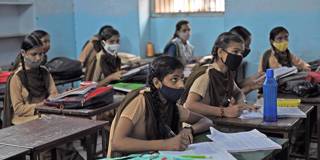Disruptions to education resulting from COVID-19, violent conflict, and climate change are leaving crisis-affected girls and boys ever-further behind. It is hard to imagine a better investment than keeping these children in school.
NEW YORK – COVID-19 is pushing the world to the brink. The pandemic has killed more than 4.7 million people, caused global GDP to decline by 4.6% in 2020, and pushed 119-124 million more people into extreme poverty. Today, nearly one in three people globally do not have enough food to eat, while conflicts and climate-change-induced natural disasters are forcing families from their homes. And the resulting school disruptions are leaving crisis-affected children ever-further behind.
When world leaders launched Education Cannot Wait, the United Nations’ global fund for education in emergencies and protracted crises, at the 2016 World Humanitarian Summit, 75 million children and youth globally were being denied their right to an education as a result of conflict, displacement, and natural disaster.
Fast forward to the present. As COVID-19 continues to ravage the world’s least-developed countries, and with other crises on the rise, the number of children who are out of school has increased to an estimated 128 million. This is a rough estimate that will likely increase as the world’s multiplying crises deepen, and it is already more than the population of Japan, or the populations of France and Italy combined. At the same time, two in three students globally are still affected by school closures. Many of them, particularly girls, may never return to full-time education, raising the risk of a surge in child marriage and child labor.

NEW YORK – COVID-19 is pushing the world to the brink. The pandemic has killed more than 4.7 million people, caused global GDP to decline by 4.6% in 2020, and pushed 119-124 million more people into extreme poverty. Today, nearly one in three people globally do not have enough food to eat, while conflicts and climate-change-induced natural disasters are forcing families from their homes. And the resulting school disruptions are leaving crisis-affected children ever-further behind.
When world leaders launched Education Cannot Wait, the United Nations’ global fund for education in emergencies and protracted crises, at the 2016 World Humanitarian Summit, 75 million children and youth globally were being denied their right to an education as a result of conflict, displacement, and natural disaster.
Fast forward to the present. As COVID-19 continues to ravage the world’s least-developed countries, and with other crises on the rise, the number of children who are out of school has increased to an estimated 128 million. This is a rough estimate that will likely increase as the world’s multiplying crises deepen, and it is already more than the population of Japan, or the populations of France and Italy combined. At the same time, two in three students globally are still affected by school closures. Many of them, particularly girls, may never return to full-time education, raising the risk of a surge in child marriage and child labor.